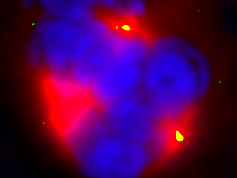

Taxanes induce tripolar instead of normal bipolar cell division. The daughter cells are more sensitive to radiation damage. DNA is stained in blue, tubulin in red and centrosomes in green.
Source: Munich University Hospital
Taxane-based radiochemotherapy* is widely used in the treatment of various locally advanced cancers – including non-small-cell lung carcinoma (NSCLC). Taxanes have two effects: they inhibit cell division, and they also sensitize tumor cells for radiation therapy.
Researchers at the Department of Radiation Therapy & Radiooncology at Munich University Hospital and the Radiation Cytogenetics Research Unit at Helmholtz Zentrum München have now demonstrated in detail how this works.
Specifically, the scientists investigated the effect of Paclitaxel, a member of the taxane family isolated from the bark of the Pacific yew (Taxus brevifolia). “By using cell biological and biochemical approaches, we were able to show in the present study that clinically relevant doses of Paclitaxel induce tripolar instead of normal bipolar cell division,” said first author Dr. Michael Orth of Munich University Hospital.
Put in simple terms, instead of dividing into two cells, the cell divides into three. “Tumor cells that have undergone such cell division subsequently respond particularly well to radiation therapy.”
Biomarkers could predict therapy success
However, the scientists found that not all tumor cells perform the taxane-mediated tripolar cell division and thus are sensitized to radiation. “The cells that respond are primarily cells that contain higher levels of the protein kinase AURKA and its cofactor TPX2,” said Professor Kirsten Lauber of Munich University Hospital. Both molecules are involved in cell division.
“We were also able to confirm the clinical relevance in a publicly accessible data set of 114 lung cancer patients,” said Dr. Kristian Unger, deputy head of the Radiation Cytogenetics Research Unit at Helmholtz Zentrum München. “Patients with particularly high expression levels of AURKA and TPX2 in the tumor had significantly longer overall survival times when treated with taxane-based radiochemotherapy.”
Accordingly, the scientists hope that they will be able to use the two molecules as biomarkers in the future in order to identify patients who can particularly benefit from taxane-based radiochemotherapy as well as patients for whom other options need to be chosen.
Co-author Professor Claus Belka, Director of the Clinic and Policlinic for Radiation Therapy and Radiation Oncology of Munich University Hospital and member of the German Consortium for Translational Cancer Research (DKTK), summarized the perspectives:
“The present study identifies AURKA and TPX2 as the first mechanism-derived biomarkers of taxane-based radiochemotherapy. This is an important prerequisite for personalized therapy decisions.” In the future, the scientists want to further investigate the molecules and examine their capacity as predictive biomarkers of taxane-based radiochemotherapy.
Further Information
* Taxanes are naturally occurring cytostatics, i.e. substances that inhibit cell growth or cell division. Radiochemotherapy (RCT) is a combination of radiation therapy (e.g. gamma irradiation) and chemotherapy (such as the administration of cytotoxic drugs) used in the treatment of malignant tumors. RCT is often more effective than either radiation or chemotherapy alone.
Background:
The German Federal Ministry of Education and Research (BMBF) will be supplying the ZiSStrans research consortium with around four million euros over the next five years. The joint project, which is being coordinated at the Helmholtz Zentrum München, has the objective of investigating new possibilities to personalize radiotherapy of head and neck cancer. Find more information on the website of the Clinical Cooperation Group Personalized Radiotherapy in Head and Neck Cancer: http://www.helmholtz-muenchen.de/en/research/research-institutions/clinical-cooperations/personalized-radiotherapy-in-head-and-neck-cancer/research/index.html
Original Publication:
Orth, M. et al. (2017): Taxane-mediated radiosensitization derives from chromosomal missegregation on tripolar mitotic spindles orchestrated by AURKA and TPX2. Oncogene, DOI: 10.1038/onc.2017.304
The Helmholtz Zentrum München, the German Research Center for Environmental Health, pursues the goal of developing personalized medical approaches for the prevention and therapy of major common diseases such as diabetes and lung diseases. To achieve this, it investigates the interaction of genetics, environmental factors and lifestyle. The Helmholtz Zentrum München is headquartered in Neuherberg in the north of Munich and has about 2,300 staff members. It is a member of the Helmholtz Association, a community of 18 scientific-technical and medical-biological research centers with a total of about 37,000 staff members. http://www.helmholtz-muenchen.de/en
The Research Unit Radiation Cytogenetics (ZYTO) investigates radiation-induced chromosome and DNA damage in cell systems and human tumours. The focus is on clarifying the mechanisms associated with radiation-induced carcinogenesis and radiation sensitivity of tumour cells. The aim of this research is to find biomarkers associated with radiation-induced tumours in order to develop personalized radiation therapy for the stratification of patients. ZYTO is a part of the Department of Radiation Sciences (DRS). http://www.helmholtz-muenchen.de/zyto
As one of Europe's leading research universities, LMU Munich is committed to the highest international standards of excellence in research and teaching. Building on its 500-year-tradition of scholarship, LMU covers a broad spectrum of disciplines, ranging from the humanities and cultural studies through law, economics and social studies to medicine and the sciences. 15 percent of LMU‘s 50,000 students come from abroad, originating from 130 countries worldwide. The know-how and creativity of LMU's academics form the foundation of the University's outstanding research record. This is also reflected in LMU‘s designation of as a “university of excellence” in the context of the Excellence Initiative, a nationwide competition to promote top-level university research. http://www.en.lmu.de
Contact for the media:
Department of Communication, Helmholtz Zentrum München – German Research Center for Environmental Health, Ingolstädter Landstr. 1, 85764 Neuherberg – Tel. +49 89 3187 2238 – Fax: +49 89 3187 3324 – E-mail: presse@helmholtz-muenchen.de
Scientific Contact at Helmholtz Zentrum München:
Dr. Kristian Unger, Helmholtz Zentrum München – German Research Center for Environmental Health, Research Unit Radiation Cytogenetics, Ingolstädter Landstr. 1, 85764 Neuherberg – Tel. +49 89 3187 3515, E-mail: unger@helmholtz-muenchen.de












